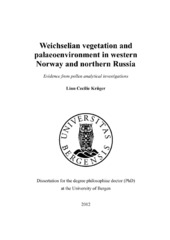| dc.contributor.author | Krüger, Linn Cecilie | eng |
| dc.date.accessioned | 2012-11-29T09:02:49Z | |
| dc.date.available | 2012-11-29T09:02:49Z | |
| dc.date.issued | 2012-06-14 | eng |
| dc.identifier.isbn | 978-82-308-2057-5 | en_US |
| dc.identifier.uri | http://hdl.handle.net/1956/6204 | |
| dc.description.abstract | This thesis focuses on the vegetation history and environmental changes in western Norway and northern Russia during the last glacial period (the Weichselian). Pollen grains deposited in lakes and bogs are used as the main palaeoecological tool to reconstruct the vegetation in this period characterised by a changing climate. The work is presented in three individual papers. Paper I deals with the vegetation development on the islands Stord and Bømlo in southern Hordaland, western Norway, at the end of the Late-Weichselian/Marine Isotope Stage (MIS) 2. The two small basins studied, Vassnestjern and Dåfjordsmyr, were deglaciated around 14.6–14.5 ka BP, which is in accordance with other studied sites in the region. The pioneer vegetation was relatively sparse and characterised by snow-bed taxa like Salix, Rumex and Oxyria in addition to grasses. The vegetation became gradually denser during the Lateglacial interstadial (Bølling-Allerød). Empetrum was an important element of the vegetation from around 13.7 ka BP. At least two short-lasting (100–150 years) episodes of reduction in humus-soil vegetation are recorded within the interstadial. These cold periods have been correlated with the GI-1d (14.025–13.9 ka BP) and GI-1b (13.26–13.05 ka BP) events in the Greenland Isotope records. Responses to the Younger Dryas (YD) cooling (12.85–11.65 ka BP) are clearly reflected as an opening of vegetation and reduction in humus-soil communities. Re-establishment of heath communities followed by the development of birch forests were responses to the Holocene warming. Paper II presents pollen records from Dimnamyra and Løkjingsmyra, two small bog basins in the Sunnmøre region, western Norway. The study revealed that the outer coast of Sunnmøre was deglaciated around 15.3 ka BP, slightly earlier than previously thought. The new records from Sunnmøre are compared with the data from southern Hordaland presented in paper I, as well as other published records from western Norway and the European continent. The pioneer vegetation, characterised by snow-bed communities, was quite similar along the coast of western Norway. However, the subsequent development of extensive heath vegetation during the Lateglacial interstadial recorded in south-western Norway is almost absent further north. The vegetation was dominated by grassland, and responses to the GI-1d and GI-1b events are not detected in the Sunnmøre records. A pronounced peak in Poaceae is recorded around 12.9 ka BP, probably reflecting warmer and/or drier conditions. The YD event is clearly reflected also in the Sunnmøre records as a change towards more open vegetation and increased occurrence of snow-bed communities. Pollen-climate transfer functions were used to reconstruct mean July temperatures (Tjul) for several sites in western Norway. Extremely little variability through the Lateglacial is reconstructed for the southern sites, and YD temperatures appear to have been overestimated. The estimated temperatures of the northern sites accord better with the biostratigraphical signals of the sites. However, all sites along the transect show similar vegetational responses, and the inconsistency in the reconstructed Tjul between the sites suggests that the results from pollen-based temperature reconstructions from the Lateglacial must be interpreted with caution. The focus of paper III is the vegetation development and the glacial history of the Polar Ural Mountains, northern Russia. Sediment and palynological records are presented from the shallow Lake Gerdizty at the eastern rim of the mountain chain. Two till beds were identified in the bottom sediments of the lake. The lowermost, fine-grained till was deposited by an ice-sheet from the Siberian lowland sometime towards the end of MIS 5 or during MIS 4. This implies that the lake is not positioned outside the limits of all Weichselian (MIS 5d– 2) glaciations, as assumed when the lake was cored. The overlying, coarser sediments originate from a local ice cap that was flowing from the mountain area in the west sometime during MIS 4, i.e. after 78 ka BP, but before ~65 ka BP when lacustrine sediments started to accumulate in the basin. Throughout the Middle Weichselian/MIS 3 and the major part of the Late Weichselian/MIS 2, the landscape was characterised by open vegetation of steppe and tundra communities. Some dwarf shrubs were present in the earliest phase, but no trees were growing locally, thus indicating summer temperatures below 10 °C. When climate improved at the end of the Late Weichselian, the vegetation became denser with increasing importance of shrubs. Birch-spruce forests developed in the vicinity of Lake Gerdizty shortly after the transition to the Holocene, indicating higher summer temperatures than today. | en_US |
| dc.language.iso | eng | eng |
| dc.publisher | The University of Bergen | en_US |
| dc.relation.haspart | Paper I: Krüger, L. C. (2009). Lateglacial vegetation and environment at the mouth of Hardangerfjorden, western Norway. Boreas 38(2): 315–334, May 2009. Full text not available in BORA due to publisher restrictions. The article is available at: <a href="http://dx.doi.org/10.1111/j.1502-3885.2008.00062.x" target="blank"> http://dx.doi.org/10.1111/j.1502-3885.2008.00062.x</a> | en_US |
| dc.relation.haspart | Paper II: Krüger, L. C., Paus, A., Svendsen, J. I. & Bjune, A. E. (2011). Lateglacial vegetation and palaeoenvironment in W Norway, with new pollen data from the Sunnmøre region. Boreas 40(4): 616–635, October 2011. Full text not available in BORA due to publisher restrictions. The article is available at: <a href="http://dx.doi.org/10.1111/j.1502-3885.2011.00213.x" target="blank"> http://dx.doi.org/10.1111/j.1502-3885.2011.00213.x</a> | en_US |
| dc.relation.haspart | Paper III: Svendsen, J. I., Krüger, L. C., Mangerud, J., Paus, A. & Murray, A. Glacial and vegetation history of the Polar Ural Mountains during the Last Ice Age. Full text not available in BORA due to publisher restrictions. | en_US |
| dc.title | Weichselian vegetation and palaeoenvironment in western Norway and northern Russia. Evidence from pollen analytical investigations | en_US |
| dc.type | Doctoral thesis | |
| dc.rights.holder | Copyright the author. All rights reserved | en_US |
